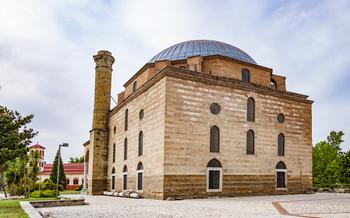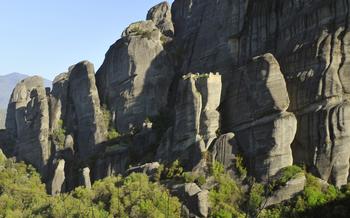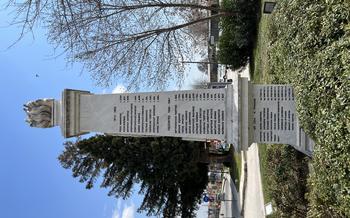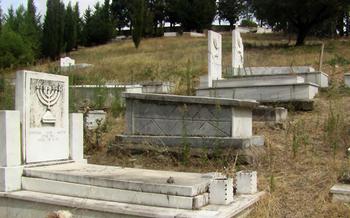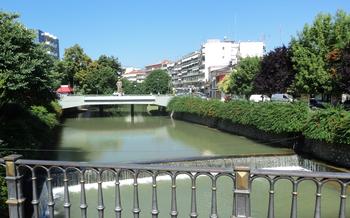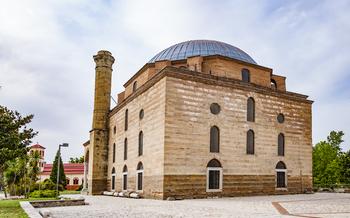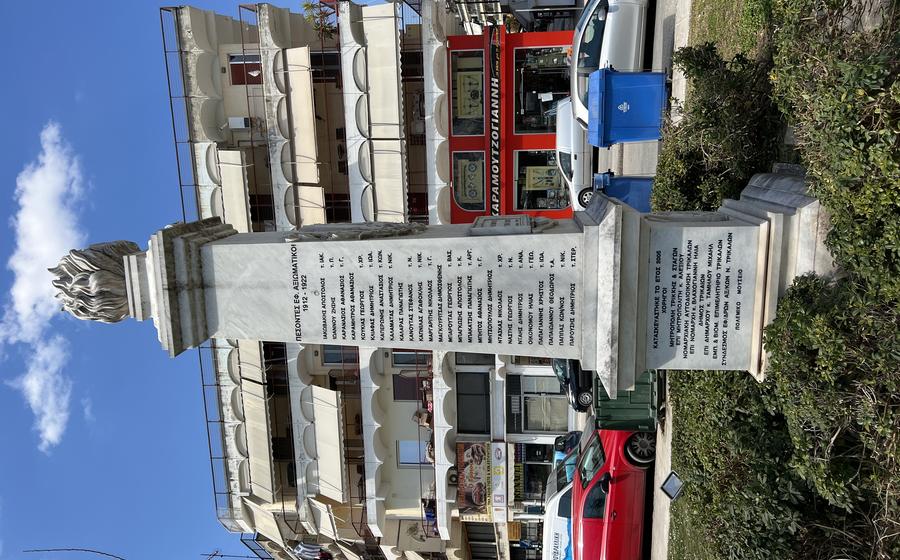
Pileas Cave
- Pileas Cave: A Natural Wonder
- Getting to Pileas Cave
- Admission Fees and Hours of Operation
- Exploring the Cave's Interior
- Educational Programs and Workshops
- Photography and Videography Guidelines
- Accessibility for Visitors with Disabilities
- Designated Paths and Wheelchair Accessibility
- Special Assistance and Accommodations
- Accessible Tours and Facilities
- Local Cuisine and Dining Options
- Nearby Attractions and Activities
- Accommodation Options for Visitors
- Shopping for Souvenirs and Local Products
- Cultural Events and Festivals
- A Walk Through History: Ancient Ruins Nearby
- Safety Precautions and Tips for Visitors
- Insider Tip: Hidden Gems of the Cave
Pileas Cave: A Natural Wonder
Nestled within the heart of Greece's Trikala region lies a testament to the earth's artistry – the Pileas Cave. This subterranean marvel, boasting an impressive history and unique geological formations, has captivated the hearts and imaginations of explorers and nature enthusiasts alike.
The history of Pileas Cave dates back to ancient times, with archaeological evidence suggesting human presence within its depths as early as the Neolithic period. However, it wasn't until the 20th century that the cave gained wider recognition, when a local shepherd stumbled upon its hidden entrance, leading to its official discovery and subsequent exploration.
What sets Pileas Cave apart are its extraordinary geological formations, a testament to nature's patient artistry over millions of years. The cave's interior is adorned with towering stalactites and delicate stalagmites that create an awe-inspiring spectacle. The result is an underground labyrinth of shimmering chambers, each with its own unique character and charm.
In recent years, the Pileas Cave has become an icon of sustainable tourism, with conservation efforts taking center stage. The local authorities have implemented strict regulations to protect the cave's delicate ecosystem, ensuring that visitors can enjoy its wonders without compromising its pristine beauty.
Getting to Pileas Cave
Pileas Cave is situated in the Thessaly region of Greece, within the Trikala prefecture. It is conveniently located near the town of Kalambaka, which serves as a gateway to the cave and the surrounding Meteora region. Kalambaka is well-connected by road, making it easily accessible from major cities in Greece.
Location and accessibility:
- Kalambaka is approximately 340 kilometers (211 miles) northwest of Athens, the capital of Greece.
- From Athens, visitors can take the scenic National Road 3 (E92) or the faster A2 motorway (Egnatia Odos).
- The journey by car takes about 4 hours, depending on traffic conditions.
Transportation options from major cities:
- Athens: Regular bus services connect Athens to Kalambaka, with a journey time of approximately 5 hours.
- Thessaloniki: Kalambaka is also accessible by bus from Thessaloniki, the second-largest city in Greece. The bus ride takes about 3 hours.
- For private transport: Visitors with their own vehicles can follow the well-marked road signs to Pileas Cave from Kalambaka.
Guided tours and private visits:
- Guided tours of Pileas Cave are available for a more in-depth experience. Tours are typically led by experienced guides who provide insights into the cave's geology, history, and unique features.
- Private visits can also be arranged for groups or individuals who prefer a more personalized experience.
Admission Fees and Hours of Operation
Admission Fees:
- Regular Ticket: 10 euros for adults, 5 euros for children (ages 5-12), and free for infants (under 5 years old).
- Group Discount (10 or more people): 8 euros per person.
- Concessions (students, seniors, military): 7 euros per person.
- Family Ticket (2 adults and 2 children): 25 euros.
Hours of Operation:
- Summer Season (June-September): 8:00 AM to 8:00 PM (last entry at 7:00 PM).
- Winter Season (October-May): 9:00 AM to 5:00 PM (last entry at 4:00 PM).
Online Booking and Reservations:
- Advance booking is recommended to secure your spot, especially during peak tourist season.
- Visit the official website of the Pileas Cave or authorized ticketing platforms to book your tickets online.
- Online booking allows you to choose your preferred time slot and avoid waiting in lines.
Exploring the Cave's Interior
The Pileas Cave is a vast underground labyrinth with an intricate layout and structure. As you venture deeper into the cave, you'll encounter a series of chambers and galleries, each with its own unique characteristics. The Main Chamber is particularly impressive, with its towering stalactites and stalagmites creating a awe-inspiring sight.
The Hall of Mirrors is another highlight, where the glistening cave walls reflect the light, creating a magical and surreal atmosphere. The Grand Canyon, a narrow and winding passage, leads to a hidden chamber known as the "Secret Garden." This secluded spot boasts a variety of delicate formations, including thin and fragile stalactites that resemble glass flowers.
Throughout the cave, you'll find an array of fascinating geological formations, including flowstones, draperies, and helictites. The cave's lighting system illuminates these features, allowing you to appreciate their intricate details. Safety measures are in place to ensure a secure and enjoyable experience, with marked paths and railings to guide your exploration.
Educational Programs and Workshops
Pileas Cave offers a range of educational programs and workshops that cater to visitors of all ages, from curious children to enthusiastic adults. Expert guides lead guided tours, providing in-depth insights into the cave's geological formations, history, and conservation efforts. These guided tours are an excellent way to learn about the cave's unique features and gain a deeper appreciation for its natural beauty.
Interactive exhibits and educational activities enhance the learning experience, making the cave a fascinating destination for school groups and families. Interactive displays, touchscreens, and hands-on exhibits engage visitors, allowing them to explore the cave's secrets in a fun and interactive way.
The cave also hosts outreach programs, collaborating with local schools and educational institutions to bring the wonders of the cave to students who may not have the opportunity to visit in person. These outreach programs aim to inspire the next generation of explorers and conservationists, fostering a sense of appreciation for the natural world.
Photography and Videography Guidelines
Capturing the beauty of Pileas Cave through photography and videography is permitted, but subject to certain guidelines to ensure the preservation of the cave's natural wonders and the safety of visitors.
Permitted Areas for Photography and Videography
Photography and videography are generally allowed within the cave, except in designated restricted areas, such as areas with fragile formations or ongoing scientific research. These restricted areas will be clearly marked with signs and barriers.
Tripod Usage and Lighting Considerations
The use of tripods and artificial lighting is generally permitted, but visitors are advised to use them responsibly and with consideration for other visitors. Tripods should not obstruct walkways or hinder the movement of others, and artificial lighting should not disturb the cave's natural environment.
Tips for Stunning Cave Images
To capture stunning images of the cave, visitors are encouraged to:
- Adjust camera settings to capture the cave's low-light conditions, using a higher ISO or a slower shutter speed.
- Use a wide-angle lens to capture the vastness and scale of the cave's chambers and formations.
- Experiment with different angles and perspectives to create visually interesting compositions.
- Look for unique lighting conditions and reflections to add depth and drama to your shots.
- Be patient and wait for the right moment to capture the perfect shot, especially if you want to avoid capturing other visitors in your photos.
Accessibility for Visitors with Disabilities
Pileas Cave is committed to providing an accessible and inclusive experience for all visitors, regardless of their abilities. Wheelchair users and individuals with disabilities can enjoy the cave's wonders thanks to designated paths and special assistance.
Designated Paths and Wheelchair Accessibility
The cave's main paths are wheelchair accessible, allowing visitors to navigate the cave's interior with ease. These paths are wide and well-lit, ensuring a safe and comfortable journey. Visitors can explore the cave's chambers, galleries, and formations without any obstacles.
Special Assistance and Accommodations
For those who require additional assistance, the cave's staff is always ready to help. They can provide wheelchairs for those who need them and offer guidance and support throughout the tour. Visitors can request assistance with boarding the cave train, navigating the paths, and accessing the different chambers.
Accessible Tours and Facilities
Guided tours are available for visitors with disabilities, ensuring that everyone can learn about the cave's history, geology, and unique features. These tours are conducted by experienced guides who are trained to provide information in a clear and accessible manner. The cave also has accessible restrooms and designated parking spaces for visitors with disabilities.
With its commitment to accessibility, Pileas Cave welcomes visitors of all abilities to explore its natural wonders and create unforgettable memories.
Local Cuisine and Dining Options
Visiting the Pileas Cave offers a unique opportunity to savor the delights of traditional Greek cuisine. The surrounding area boasts an array of restaurants and tavernas serving authentic dishes crafted with fresh, local ingredients. Indulge in mouthwatering souvlaki, grilled meats, and seafood delicacies, all prepared with the region's renowned olive oil and herbs. Don't miss out on the chance to try local specialties like the savory pies known as "spanakopita" and "tyropita," filled with spinach and feta cheese, respectively.
For a delightful picnic experience, pack a lunch and head to one of the designated picnic spots within the vicinity of the cave. Enjoy a leisurely meal surrounded by nature's beauty, savoring the flavors of local cheeses, olives, and freshly baked bread. Whether you choose to dine at a traditional restaurant or opt for a picnic, immersing yourself in the local cuisine is an essential part of exploring the Pileas Cave region. Support the local economy by purchasing products from family-run businesses and specialty shops, where you can find unique handicrafts, traditional souvenirs, and delectable local delicacies.
Nearby Attractions and Activities
Beyond the captivating depths of Pileas Cave, the region offers an array of enticing destinations to complement your visit. For those with an adventurous spirit, the enchanting Cave of Theopetra, located just a short drive away, beckons with its ancient history and mesmerizing rock formations. Nature enthusiasts will revel in the scenic beauty of Meteora, a breathtaking complex of monasteries perched atop towering rock pillars, offering awe-inspiring views and an unforgettable experience.
If you seek a glimpse into the region's rich cultural heritage, venture to the nearby town of Trikala. Wander through its charming cobblestone streets, admire the traditional architecture, and delve into the fascinating history of this vibrant town. For a unique perspective, embark on a scenic cycling tour through the picturesque countryside, immersing yourself in the tranquil landscapes and discovering hidden gems along the way.
Whether you seek adventure, history, or simply relaxation amidst nature's wonders, the surroundings of Pileas Cave offer an abundance of experiences to enrich your visit. Embrace the opportunity to explore these captivating destinations and create lasting memories in this enchanting region.
Accommodation Options for Visitors
When planning your visit to Pileas Cave, a range of accommodation options await you to ensure a comfortable and memorable stay. Whether you prefer the convenience of hotels or the charm of traditional guesthouses, there are choices to suit every traveler. For those seeking a more immersive experience, rental apartments offer a home away from home, allowing you to soak in the local culture.
If you're an outdoor enthusiast, camping and caravan parks provide a unique opportunity to connect with nature. These facilities offer designated camping grounds, allowing you to pitch your tent or park your caravan under the starry sky. With stunning views of the surrounding landscape, camping provides an unforgettable experience for adventure seekers.
To make the most of your stay, consider booking your accommodation in advance, especially during peak tourist seasons. Online platforms and local travel agencies can assist you in finding the best deals and availability. Whether you're seeking a luxurious hotel room, a cozy guesthouse, or a secluded camping spot, Trikala has options to cater to every traveler's needs.
Shopping for Souvenirs and Local Products
When visiting Pileas Cave, take the opportunity to explore the local markets and specialty shops to find unique handicrafts and traditional souvenirs. Support the local economy by purchasing handmade items, such as pottery, textiles, and jewelry, created by skilled artisans. Browse through colorful displays of local products, including honey, olive oil, and herbs, to savor the flavors of the region. Embrace the vibrant culture of Greece by bringing home a piece of its artistic heritage and culinary delights.
Cultural Events and Festivals
Trikala and the surrounding region are home to a vibrant cultural scene, with several annual events and festivals that showcase the rich heritage and traditions of Greece. Don't miss the opportunity to experience the infectious energy and warm hospitality of the locals as they celebrate their culture through music, dance, and food.
-
Trikala Folklore Festival: Held in August, this festival brings together local folk dance groups, musicians, and artisans to celebrate traditional Greek culture. Watch mesmerizing performances, join in on the dancing, and savor delicious local cuisine.
-
Meteora Monasteries Festival: This unique festival, held in June, features traditional music concerts, art exhibitions, and guided tours of the iconic Meteora monasteries, perched atop towering rock formations.
-
Trikala Wine Festival: If you're a wine enthusiast, don't miss this festival in September, where local wineries showcase their finest vintages. Enjoy wine tastings, culinary delights, and live music in the heart of Trikala.
-
Greek Orthodox Easter Celebrations: Experience the fervor and spirituality of Greek Orthodox Easter in Trikala. Witness the candlelit processions, attend church services, and indulge in traditional Easter delicacies like tsoureki (sweet bread) and red-dyed eggs.
A Walk Through History: Ancient Ruins Nearby
Pileas Cave is not only a natural wonder but also a region steeped in ancient history. Just a short distance from the cave, visitors can explore a wealth of historical sites and archaeological remains that offer a glimpse into the region's rich past.
Historical Sites and Archaeological Remains:
- Ancient Theaters:
Stroll through the ruins of ancient theaters where performances of Greek tragedies and comedies once captivated audiences. Imagine the echoes of laughter and applause as you explore the well-preserved seating areas and stage foundations.
- Temples and Sanctuaries:
Discover ancient temples dedicated to Greek gods and goddesses. Admire the intricate architectural details and marvel at the stories and legends associated with these sacred spaces.
- Fortifications and City Walls:
Explore the remains of ancient fortifications and city walls that once protected settlements from invaders. Walk along the ramparts, admire the defensive structures, and imagine the battles and sieges that took place here.
Exploring the Region's Rich History:
- Guided Tours and Local Experts:
Take advantage of guided tours led by local experts who can provide insights into the history and significance of the archaeological sites. Learn about the ancient civilizations that inhabited the region and the events that shaped their lives.
- Interactive Exhibits and Displays:
Visit museums and cultural centers that showcase artifacts, replicas, and interactive exhibits related to the region's history. Engage with immersive displays that bring the past to life and offer a deeper understanding of the ancient world.
- Self-Guided Exploration:
For a more independent experience, embark on a self-guided exploration of the historical sites. Follow designated paths, read informative signs, and let your imagination transport you back in time as you wander among the ruins.
Safety Precautions and Tips for Visitors
Visiting the Pileas Cave requires adherence to specific safety measures to ensure a safe and enjoyable experience. Visitors should wear comfortable, non-slip footwear and clothing suitable for uneven surfaces and low temperatures inside the cave. Designated paths and walkways must be followed to avoid potential hazards and protect the cave's delicate formations. Touching or damaging the cave's structures, including stalactites and stalagmites, is strictly prohibited. Respecting the natural environment and wildlife within the cave is crucial. Visitors should avoid disturbing the ecosystem by refraining from littering, making excessive noise, or bringing pets inside the cave. Additionally, smoking and open flames are prohibited within the cave premises for safety reasons. By following these guidelines, visitors can contribute to the preservation of this natural wonder while ensuring their own safety and the enjoyment of future generations.
Insider Tip: Hidden Gems of the Cave
For an unforgettable experience, venture beyond the main tourist routes and seek out the hidden treasures of Pileas Cave. One such gem is the "Secret Chamber," a secluded alcove adorned with glistening stalactites and stalagmites that have formed over millennia. To find it, follow the path less traveled and keep an eye out for a narrow passageway tucked away behind a rock formation.
Another must-see is the "Enchanted Forest," a cluster of delicate and intricate cave formations that resemble a miniature forest. The interplay of light and shadow creates a magical atmosphere that will transport you to a realm of fantasy. Discover this hidden wonder by taking a guided tour that includes access to restricted areas.
For photography enthusiasts, the cave's "Crystal Grotto" offers a unique opportunity to capture stunning images. This chamber features an abundance of sparkling crystals that reflect and refract light, creating a mesmerizing spectacle. To capture the best shots, use a tripod and adjust your lighting to highlight the intricate details of the crystals.
Remember, exploring these hidden gems requires caution and respect for the cave's delicate ecosystem. Always stay on designated paths, avoid touching or damaging the formations, and follow any instructions provided by your guide. Embrace the adventure, unlock the secrets of Pileas Cave, and cherish the memories of your subterranean journey.
